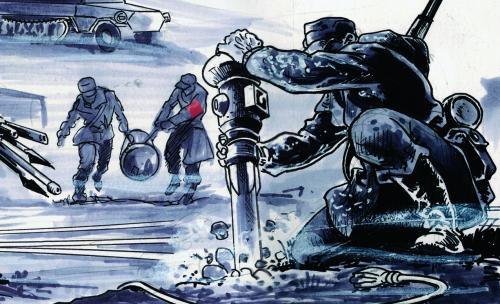In Williams’ graphic novel, RED FOG, the zombie poster boy is Martin Bormann the real life, circa 1945, Nazi official who had absolute power over access to Hitler by controlling Hitler’s finances, paperwork, and appointments. Bormann disappeared in May of 1945 during the Third Reich’s last stand.
Recently I received a message from an animator friend of mine via Facebook about a graphic novel he is working on. It’s not really breaking news that an animation artist is working on a graphic novel with hopes for a film adaptation. It’s more of a cliché in Los Angeles for artists to have a day job in the industry and work on their own art projects in their free time. The interesting thing about William’s email was the mechanism he was using to raise funds to see the project through to its fruition.
I first met Canadian born animator Chris Williams eight years ago when we were both working on Spider-Man 2 for Sony Pictures Imageworks. He was, and continues to be, a top of the line animator and we’ve kept in touch over the years. In addition to being an animator, Williams is also a huge lover of animation. It’s this love of animation, along with his knowledge of WWII history that takes center stage in his current side project, RED FOG. Williams took up writing when he was overrun with canvas’ from his painting. “It took up less space,” he jokes. RED FOG is a graphic novel with story by Chris Williams and art by Mike Docherty. Docherty has been a comic artist for over 30-years and has worked for Marvel, Warner Bros. and Sony. His work is dark and bold and suits the story that Williams has created.
The modern day zombie has firm roots in George A. Romero’s amazing NIGHT OF THE LIVING DEAD circa 1968. Since then zombies have become a metaphor for unchecked evil to be avoided at all costs. Zombies have no nation, no culture and no ACLU lawyers. They are available to be the bad guys in any situation.
In Williams’ graphic novel, RED FOG, the zombie poster boy is Martin Bormann the real life, circa 1945, Nazi official who had absolute power over access to Hitler by controlling Hitler’s finances, paperwork, and appointments. Bormann disappeared in May of 1945 during the Third Reich’s last stand. It was rumored that he had been killed and buried, but no body was found in the given location at the time. He was tried at the Nuremberg war crimes trials, in absentia, and was sentenced to die, again, in absentia. In 1998, his body was found near the original area he was rumored to have been buried, and identified through DNA. Still there are those who believe he survived the end of the war and his body was buried where it could be found only after he died a natural death. Could you ask for a more evil, wretched zombie villian?

Williams story takes place in 1951, six years after fall of Hitler. Bormann is still dedicated to the goals of the Third Reich and Hitler’s memory. He has built up an army “so powerful, so horrific, that the dream of the 1000 year Reich will finally be realized.” Cue carnage.
The normal process that gets a project from the artist brain to an audience is different for different end user media. Graphic novels, novels, scripts all go through a pitch process. The traditional pitch process, like so many formerly artistic endeavors, has become commodified and corporatized to the point that it is difficult, if not impossible for the average artist with a talent and a good idea to get a time slot in front of the right people who can greenlight a project. Then, often, once a project is greenlit, a multitude of interested parties show up to tweak and twist the original work into something that everyone can say they had a hand in creating. So while a project may come to public attention, the end result might not always be what the artist intended.
Enter kickstarter.com a website that allows artists a forum to pitch their projects. The site was founded in April 2009 by Perry Chen, Yancey Strickler and Charles A. Adler. The really unique thing about kickstarter.com is that it calls for anyone in the world who likes, believes in or is otherwise interested in seeing a project succeed, to put their money where their mouth is and shell out some cold hard cash. Thus the project receives a sort of everyman backing that reflects the amount of real interest held by a paying audience rather than the projected possibilities that studios and publishers use. Additionally, you don’t have to do a lot of market research to know who your audience is because they have come to you in a very direct way.
Kickstarter does small scale mimicking of the project production process in other ways as well. There are Backer Levels, and the project creators have the option of giving a cool memento of the project at each level. For William’s project the goal amount to print the book is $8,400. They can bring in more, but if they don’t meet their goal within 60 days, then they receive nothing and all the backers are off the hook for their pledges. However, if the project is fully funded, backers will be sent anything from a signed copy of the book to signed, original, art prints. My favorite is a chance to be a zombie extra in the book.
As of today, RED FOG has 100 backers and 20 days to go. Can they meet their goal? Will consumer based backing go viral? Who knows? For now, I’m happy to watch and wait.











